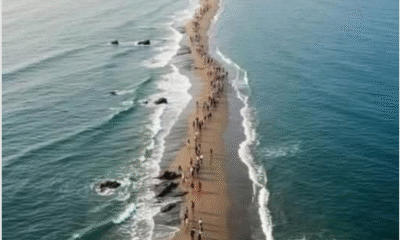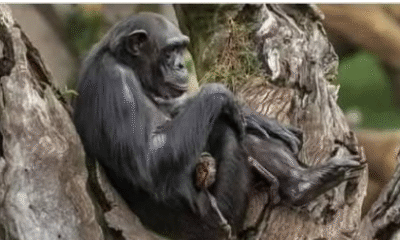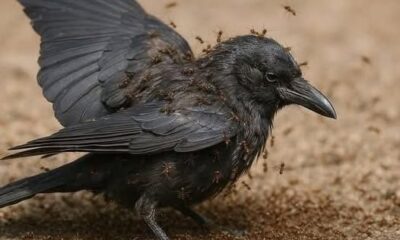story
Natalia the Chimpanzee: A Heartbreaking Lesson in Love and Grief

At Bioparc Valencia, an emotional story unfolded that touched hearts around the world. A chimpanzee named Natalia lost her baby — yet for seven long months, she refused to let go.
Day after day, Natalia carried the lifeless body of her infant close to her chest. She groomed him, protected him, and held him gently, as if he were still alive. It was her way of coping with unimaginable loss — a mother’s love that refused to fade.
A Mother’s Grief Beyond Words
Zookeepers at Bioparc chose not to intervene. They understood that grief is a deeply personal journey — even for animals. Natalia was given the freedom to decide when she was ready to say goodbye.
For seven months, she kept her baby close. The once-soft body eventually became just dry skin and bones, but to Natalia, it was still her child. Every day, she carried him with the same care and tenderness.
When Nature Teaches Us About Emotion
Finally, on September 21, Natalia laid her baby down and walked away. It was a quiet, heartbreaking moment — but also a powerful reminder that grief is not only human.
Chimpanzees, like humans, experience complex emotions — love, loss, attachment, and mourning. Scientists have long observed that primates show deep empathy, and Natalia’s story is one of the clearest examples of this truth.
The Universal Language of Love
Natalia’s grief shows that love knows no boundaries of species. Her silent mourning speaks a language we all understand — the pain of losing someone we love and the struggle to let go.
Through her, we are reminded that animals feel deeply, form unbreakable bonds, and deserve the same compassion we give to one another.
A Reflection for Us All
Natalia’s story isn’t just about a chimpanzee. It’s about motherhood, love, and the universal nature of grief. It teaches us that emotions connect all living beings — and that empathy is one of nature’s greatest gifts.
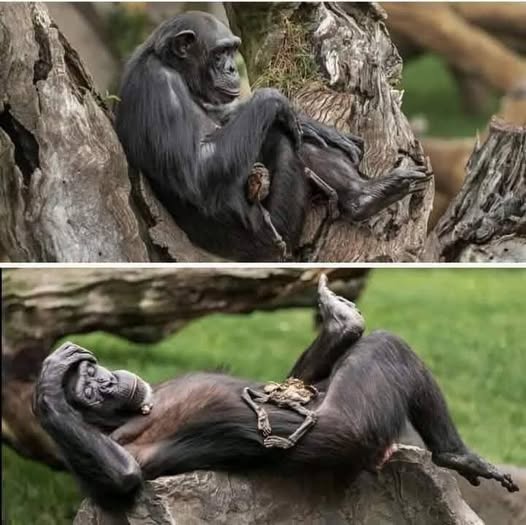
story
Gloria Steinem: The Woman Who Went Undercover to Expose the Truth Behind the Playboy Fantasy

Before she became the face of modern feminism, Gloria Steinem was an ambitious young journalist trying to be taken seriously in a male-dominated world. In 1963, she accepted an assignment that would change her life — and the way America saw women.
To uncover the reality behind the glamour, Steinem went undercover as a Playboy Bunny at the New York Playboy Club. From the outside, it seemed like a world of elegance and excitement — cocktails, celebrities, and a promise of luxury. But what she discovered beneath the satin ears and fishnet stockings was a very different story.
Behind the Bunny Ears: A Reality Few Saw
The job demanded constant smiles, perfect figures, and endless patience. The handbook for Bunnies spelled out strict, humiliating rules: never gain weight, keep your tail fluffy, accept flirting politely, and never complain.
Steinem soon realized the glamour was only a disguise for exhaustion, low pay, and everyday harassment. Her investigative piece, “A Bunny’s Tale,” ripped away the fantasy and revealed how women’s bodies were being marketed as entertainment. It became one of the most talked-about exposés of its time — and the moment Steinem’s voice began to reshape journalism.
The Struggles That Forged Her Strength
Gloria’s courage didn’t appear overnight. Her childhood was marked by hardship. Her father left when she was young, leaving her to care for her emotionally fragile mother while constantly moving from place to place.
By the time she entered journalism, Steinem already knew what it meant to feel unseen. Editors often handed her “women’s stories” — light features about fashion and lifestyle — while her male peers got political assignments. But she used those very topics to reveal the hidden realities of women’s lives, turning limitations into opportunity.
From Bunny to Icon: The Rise of a Movement
After “A Bunny’s Tale”, Steinem became a symbol of a new kind of feminism. In the 1970s, she co-founded Ms. Magazine, giving women a powerful platform for their voices. With her signature aviator sunglasses and calm determination, she became the public face of women’s liberation — speaking out for reproductive rights, equal pay, and an end to domestic violence.
Even as critics dismissed her for being “too pretty” or “too radical,” Steinem’s focus never wavered. She transformed ridicule into momentum, and silence into social change.
The Reluctant Leade
Despite her fame, Gloria often described herself as “an introvert in public.” She preferred listening to talking, yet carried the expectations of millions of women on her shoulders. Her humility made her message even stronger — a reminder that leadership doesn’t require ego, only courage.
She never sought to be a hero, but history made her one.
A Legacy of Voice and Visibility
Gloria Steinem’s story is more than a chronicle of feminism — it’s about resilience, empathy, and transformation. From a girl who grew up feeling invisible, she became the woman who taught the world to see.
Through disguises, magazine pages, and movements, Steinem gave voice to those who had none — proving that sometimes, to change the system, you have to step inside it first.
story
The Miracle of Jindo: When the Sea Opens in South Korea

Twice a year, a breathtaking natural event takes place in South Korea — something so extraordinary that it’s known as “The Miracle of Jindo.”
For just about one hour, the sea between Jindo and Modo Islands parts, revealing a natural pathway more than two kilometers long. Thousands of visitors from around the world gather to witness this rare phenomenon, walking across the sea on foot as waves gently divide on either side.
A Natural Wonder of Tides
This stunning event is not magic, but the result of a unique tidal phenomenon. Powerful ocean currents and lunar cycles align perfectly to temporarily lower the water level, uncovering a narrow land bridge between the two islands.
Locals celebrate this moment with music, colorful festivals, and traditional dances. For them, it’s not just a scientific event — it’s a symbol of hope and connection, linking generations through legend and culture.
The Legend Behind the Miracle
According to local folklore, the miracle began centuries ago when a woman named Bbyong prayed for a path to reunite with her family stranded on another island. In answer to her prayers, the sea is said to have opened — allowing her and others to cross safely.
Since then, the event has been honored as a reminder of faith, unity, and the mysterious harmony between nature and humanity.
A Festival Like No Other
Every spring and summer, the Jindo Sea-Parting Festival draws thousands of tourists eager to experience this wonder firsthand. Dressed in vibrant colors, visitors walk the newly revealed seabed, collecting shells, taking photos, and celebrating together before the tide slowly returns.
It’s a magical sight — one that captures the beauty of South Korea’s coastal spirit and the deep connection its people share with nature.
A Reminder of Nature’s Magic
The Miracle of Jindo is a rare gift from nature, reminding us how perfectly the Earth moves in rhythm with the moon and tides. For a brief moment, people can literally walk through the sea, experiencing the balance between science and wonder.
When the waters close again, only footprints and memories remain — until the next time the sea opens its path once more.
story
When a Crow Feels Sick, It Visits an Anthill — Here’s Why
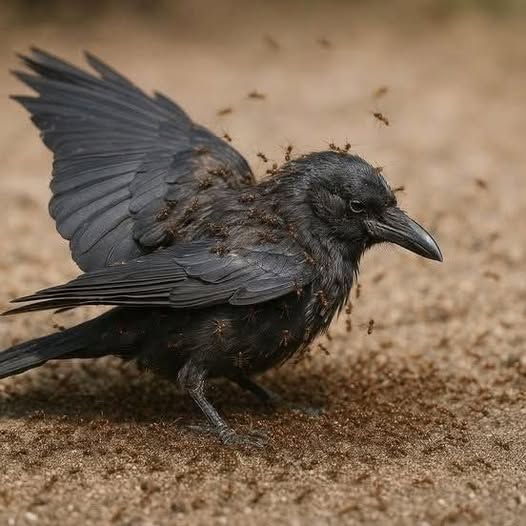
Nature has a way of surprising us with its intelligence — and the humble crow is one of the most fascinating examples. These birds are known for their problem-solving skills and adaptability, but few people know they also practice a form of natural healing.
When a crow begins to feel sick or weak, it doesn’t seek out medicine or shelter. Instead, it visits a place you’d never expect — an anthill.
A Strange but Smart Behavior
Imagine seeing a crow landing on the ground, spreading its wings wide, and lying perfectly still over an anthill. At first, it might look like something’s wrong — but what’s really happening is one of the most extraordinary natural rituals in the animal kingdom.
The crow remains motionless as dozens of ants crawl over its body and into its feathers. It’s not random behavior — it’s a deliberate act of self-care that scientists call “anting.”
The Science Behind “Anting”
So, why do crows let ants crawl all over them? The answer lies in chemistry.
Ants release a substance called formic acid, which acts as a natural disinfectant. When the ants come into contact with the crow’s feathers, this acid helps kill bacteria, fungi, and parasites that can cause illness. It’s like a built-in bird spa — one that nature designed perfectly.
This behavior helps crows clean their feathers, remove harmful microbes, and even soothe itchy skin caused by mites or other irritants.
Not Just Crows — Nature’s Shared Wisdom
Interestingly, crows aren’t the only birds that do this. Researchers have observed robins, jays, starlings, and even wild turkeys performing the same ritual. Some birds pick up ants in their beaks and rub them directly onto their feathers — a behavior known as “active anting.” Others, like crows, simply lie down and let the ants do the work — known as “passive anting.”
This shows how deeply instinctive and intelligent animals can be. Without laboratories or doctors, they’ve discovered effective ways to heal and protect themselves — all through natural instincts passed down through generations.
Nature’s Own Medicine Cabinet
The story of the crow reminds us that nature is its own pharmacy. Every living creature, from birds to insects, has evolved unique ways to stay healthy and balanced.
Humans often overlook these small wonders, focusing only on modern medicine — but there’s a lot we can learn from watching the natural world. The crow’s behavior teaches us that sometimes, the simplest solutions are the smartest ones.
A Lesson in Observation and Respect
Every time a crow visits an anthill, it demonstrates a quiet wisdom. It knows what its body needs, when to rest, and how to heal — all without external help.
It’s a powerful reminder for us too: when we slow down, observe, and trust nature’s rhythm, we realize how much healing power exists all around us.
From forests to oceans, from ants to birds — life constantly finds ways to survive, adapt, and thrive. All we have to do is pay attention.
Moral of the Story
The next time you see a crow sitting on the ground near an anthill, remember — it’s not strange behavior. It’s instinctive self-healing in action.
Nature’s intelligence doesn’t shout; it whispers through the behavior of creatures like the crow. And in that quiet wisdom, we find one of life’s greatest lessons — healing doesn’t always require complexity. Sometimes, it just takes trust in nature’s balance.
The world around us is full of natural miracles, often hidden in plain sight. “Anting” is more than just a bird behavior — it’s a beautiful reflection of how deeply connected and intelligent life on Earth truly is.
The crow’s instinct to heal itself shows us that every creature, no matter how small or common, carries within it a spark of nature’s brilliance.

 Things To Do2 years ago
Things To Do2 years agoAngel Fire or Red River: Which New Mexico Mountain Town is Right for You?

 Beaches2 years ago
Beaches2 years agoDoes Allegiant Air offer flights to Daytona Beach?

 Travel FAQs2 years ago
Travel FAQs2 years agoWhat are the dimensions of an average hotel room?

 Beaches2 years ago
Beaches2 years agoIs Driving Allowed on Panama City Beach?

 Things To Do2 years ago
Things To Do2 years agoHow Far is the Distance Between Fort Lauderdale and Miami’s South Beach?

 Things To Do2 years ago
Things To Do2 years agoWhy is Hanakapiai Beach considered one of the most dangerous beaches in Hawaii?
- RV CAMPING1 year ago
When a woman wakes up, a random dog is in her bed

 Travel FAQs2 years ago
Travel FAQs2 years agoWhat are some fun activities to do at the beach at night?







